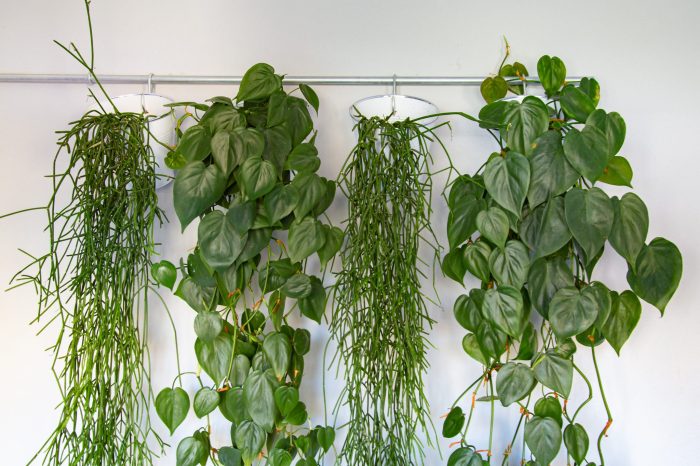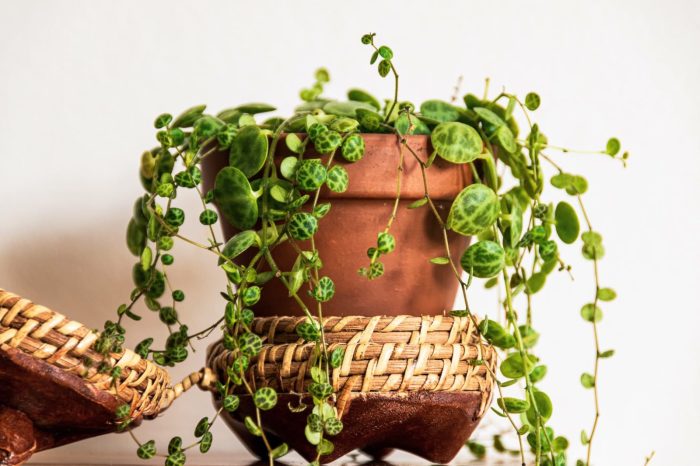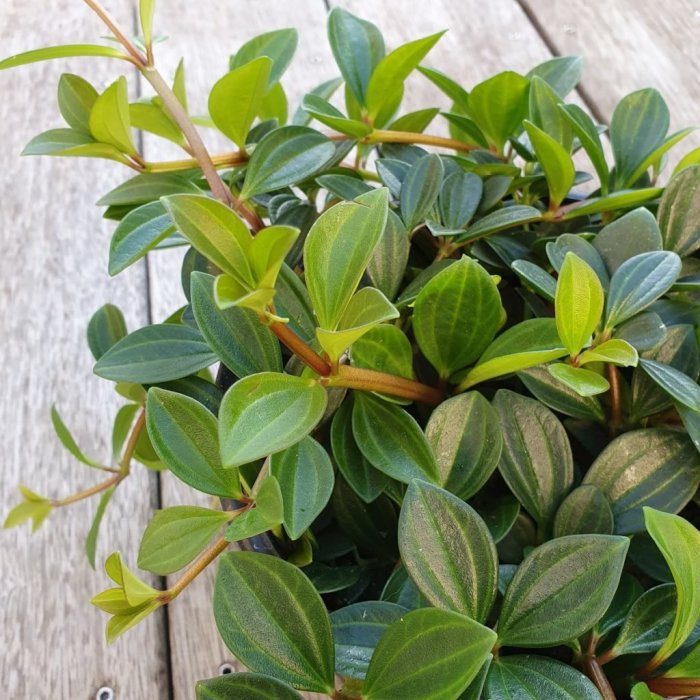Small trailing indoor plants, with their captivating foliage and ability to add a touch of nature to any space, are gaining immense popularity among home decorators and plant enthusiasts alike. From cascading pothos to delicate string of pearls, these plants offer a diverse range of shapes, textures, and colors, making them perfect for adding visual interest and a sense of tranquility to your indoor spaces.
In this comprehensive guide, we will explore the characteristics of small trailing indoor plants, discover popular varieties, delve into their care and maintenance, and provide creative ideas for incorporating them into your home decor. Additionally, we will identify suitable companion plants that complement these trailing beauties, creating a harmonious and visually appealing indoor oasis.
Characteristics of Small Trailing Indoor Plants

Small trailing indoor plants are a popular choice for home decorators looking to add a touch of greenery to their space. These plants are typically characterized by their compact size, making them ideal for small apartments or windowsills. Their trailing growth habit allows them to cascade over the edges of pots or planters, creating a lush and eye-catching display.
Size and Shape
Small trailing indoor plants typically range in size from a few inches to a few feet in length. Their compact size makes them easy to place in a variety of locations, from desks and tables to shelves and windowsills. The trailing growth habit of these plants allows them to create a cascading effect, adding visual interest and texture to any space.
Leaf Shapes and Textures
Small trailing indoor plants come in a wide variety of leaf shapes and textures. Some popular varieties include:
- Heart-shaped leaves:Plants like the sweetheart plant (Philodendron scandens) and the pothos (Epipremnum aureum) have heart-shaped leaves that add a touch of whimsy to any space.
- Round leaves:The pennywort (Hydrocotyle vulgaris) and the baby’s tears (Soleirolia soleirolii) have small, round leaves that create a delicate and airy effect.
- Variegated leaves:Many small trailing indoor plants have variegated leaves, which means they have multiple colors or patterns. The golden pothos (Epipremnum aureum ‘Golden’) and the tricolor ivy (Hedera helix ‘Tricolor’) are popular choices for their striking foliage.
Colors
Small trailing indoor plants come in a variety of colors, from deep greens to vibrant purples. Some popular varieties include:
- Green:The emerald green leaves of the pothos (Epipremnum aureum) and the spider plant (Chlorophytum comosum) add a touch of freshness to any space.
- Purple:The purple heart plant (Tradescantia pallida) and the wandering jew (Tradescantia zebrina) have vibrant purple leaves that add a pop of color to any room.
- Variegated:Many small trailing indoor plants have variegated leaves, which means they have multiple colors or patterns. The golden pothos (Epipremnum aureum ‘Golden’) and the tricolor ivy (Hedera helix ‘Tricolor’) are popular choices for their striking foliage.
Uses in Interior Design
Small trailing indoor plants are a versatile addition to any home décor. They can be used to add a touch of greenery to a bookshelf, create a lush display on a windowsill, or hang from a ceiling to create a dramatic effect.
Their trailing growth habit makes them ideal for adding a touch of whimsy and texture to any space.
Popular Varieties of Small Trailing Indoor Plants
Small trailing indoor plants add a touch of greenery and elegance to any space. They are easy to care for and can thrive in a variety of environments. Here are some of the most popular varieties:
Spider Plant
- Botanical Name: Chlorophytum comosum
- Common Name:Spider Plant
- Growth Habit:Forms long, arching stems with rosettes of leaves at the ends.
- Light Requirements:Prefers bright, indirect light but can tolerate low light.
- Care:Water when the soil is dry to the touch. Fertilize monthly during the growing season.
- Appearance:Long, narrow leaves with a variegated pattern of green and white.
String of Pearls
- Botanical Name: Senecio rowleyanus
- Common Name:String of Pearls
- Growth Habit:Forms long, trailing stems with small, round leaves that resemble pearls.
- Light Requirements:Prefers bright, indirect light but can tolerate low light.
- Care:Water sparingly, allowing the soil to dry out completely between waterings.
- Appearance:Long, trailing stems with small, round, green leaves.
Burro’s Tail
- Botanical Name: Sedum morganianum
- Common Name:Burro’s Tail
- Growth Habit:Forms long, trailing stems with fleshy, cylindrical leaves that resemble a burro’s tail.
- Light Requirements:Prefers bright, indirect light but can tolerate low light.
- Care:Water sparingly, allowing the soil to dry out completely between waterings.
- Appearance:Long, trailing stems with fleshy, cylindrical, blue-green leaves.
Creeping Fig
- Botanical Name: Ficus pumila
- Common Name:Creeping Fig
- Growth Habit:Forms long, trailing stems with small, heart-shaped leaves.
- Light Requirements:Prefers bright, indirect light but can tolerate low light.
- Care:Water when the soil is dry to the touch. Fertilize monthly during the growing season.
- Appearance:Long, trailing stems with small, heart-shaped, green leaves.
Wandering Jew
- Botanical Name: Tradescantia zebrina
- Common Name:Wandering Jew
- Growth Habit:Forms long, trailing stems with variegated leaves.
- Light Requirements:Prefers bright, indirect light but can tolerate low light.
- Care:Water when the soil is dry to the touch. Fertilize monthly during the growing season.
- Appearance:Long, trailing stems with variegated leaves that are green, purple, and silver.
Care and Maintenance of Small Trailing Indoor Plants
Nurturing small trailing indoor plants requires specific care and maintenance to ensure their health and aesthetic appeal. By adhering to optimal conditions and addressing common issues, these delicate plants can thrive and add a touch of greenery to any indoor space.
Watering
Trailing indoor plants have varying water needs depending on their species and the environment. Allow the top inch of soil to dry out before watering to prevent overwatering, which can lead to root rot. Use room-temperature water and avoid using tap water that contains fluoride or chlorine, as these can damage the plants.
Fertilizing
Fertilize trailing indoor plants every 2-3 weeks during the growing season (spring and summer) with a balanced liquid fertilizer diluted to half strength. Avoid over-fertilizing, as this can burn the roots. Stop fertilizing during the dormant season (fall and winter).
Small trailing indoor plants add a touch of greenery and freshness to any room. To enhance their aesthetic appeal and save space, consider using wall mount plant hangers indoor . These hangers allow you to suspend your plants vertically, creating a cascading effect that adds visual interest.
Whether you have a few small trailing plants or a collection, wall mount plant hangers indoor provide a practical and stylish solution for displaying them in your home.
Repotting
Repot trailing indoor plants when they become rootbound or outgrow their current pot. Choose a pot that is 1-2 inches larger in diameter than the previous one and use a well-draining potting mix. Repotting should be done in spring or summer when the plants are actively growing.
Light Conditions
Most small trailing indoor plants prefer bright, indirect light. Avoid placing them in direct sunlight, as this can scorch their leaves. If natural light is limited, consider using grow lights to supplement the lighting.
Small trailing indoor plants add a touch of greenery to any room, and they’re perfect for those who don’t have a lot of space. These plants can be placed on shelves, tables, or even hung from the ceiling. If you’re looking for a low-maintenance plant that will thrive in low light conditions, consider a low light hanging plant . These plants are ideal for small spaces and can add a touch of elegance to any room.
They come in a variety of shapes and sizes, so you’re sure to find one that fits your needs.
Humidity Levels
Trailing indoor plants benefit from higher humidity levels. Misting them regularly or placing them on a tray filled with pebbles and water can increase the humidity around the plants.
Temperature Ranges
Most small trailing indoor plants prefer temperatures between 65-75°F (18-24°C). Avoid exposing them to extreme temperatures, as this can damage their foliage.
Troubleshooting Common Problems
- Yellowing Leaves:Overwatering, underwatering, or nutrient deficiency can cause yellowing leaves. Adjust watering and fertilizing schedules accordingly.
- Stunted Growth:Lack of light, nutrients, or space can stunt growth. Provide adequate lighting, fertilize regularly, and repot if necessary.
- Pests:Aphids, mealybugs, and spider mites are common pests that can infest trailing indoor plants. Treat infestations promptly with insecticidal soap or neem oil.
Creative Uses for Small Trailing Indoor Plants
Small trailing indoor plants offer a plethora of creative opportunities to elevate home decor and bring a touch of nature indoors. These versatile plants can be incorporated into various settings, adding a touch of elegance and greenery to any space.
Hanging Baskets
Hanging baskets are a classic way to showcase small trailing plants. Suspended from the ceiling or wall, these baskets create a cascading effect, with the plants’ tendrils gracefully flowing downwards. This arrangement is perfect for adding a touch of greenery to corners or above windows, where natural light is abundant.
Vertical Gardens
Vertical gardens are a space-saving solution that transforms walls into living works of art. Small trailing plants can be used to create lush vertical displays, adding a touch of nature to even the smallest of spaces. These gardens can be easily customized to fit any wall size or shape, creating a unique and eye-catching focal point.
Table Centerpieces
Small trailing plants can also be used to create stunning table centerpieces. Arrange them in a shallow dish or vase, allowing their tendrils to cascade over the edges. This creates a dramatic and elegant centerpiece that adds a touch of natural beauty to any dining table or coffee table.
Aesthetic Benefits
Incorporating small trailing indoor plants into home decor offers numerous aesthetic benefits. Their lush greenery and cascading tendrils add a touch of freshness and vitality to any space. These plants can also help purify the air, improving indoor air quality and creating a healthier living environment.
Companion Plants for Small Trailing Indoor Plants

Pairing small trailing indoor plants with suitable companion plants can enhance their growth and create visually appealing displays. Companion plants provide various benefits, including improved air quality, reduced pests, and enhanced aesthetics.
When selecting companion plants, consider factors such as growth habits, light requirements, and water needs. Plants with similar growth habits, such as trailing or cascading foliage, can complement each other well. Additionally, plants with contrasting leaf textures or colors can create a dynamic and visually interesting display.
Recommended Companion Plants, Small trailing indoor plants
- Peperomia: Small, compact plants with trailing stems and variegated foliage. They prefer bright, indirect light and well-draining soil.
- Spider Plant (Chlorophytum comosum) : Easy-care plants with long, trailing leaves that produce plantlets. They tolerate a wide range of light conditions and prefer moist soil.
- String of Pearls (Senecio rowleyanus) : Delicate, trailing succulent with bead-like leaves. It requires bright, indirect light and infrequent watering.
- Baby’s Tears (Soleirolia soleirolii) : Tiny, creeping groundcover with dense, mat-like foliage. It prefers moist soil and bright, indirect light.
- Creeping Jenny (Lysimachia nummularia) : Vigorous, trailing plant with round, green leaves. It prefers moist soil and can tolerate partial shade.
These companion plants complement the trailing growth habit of small indoor plants, creating a lush and visually appealing display. They also provide benefits such as air purification, pest deterrence, and enhanced soil health.
Concluding Remarks

Whether you are a seasoned plant parent or just starting your journey into the world of indoor gardening, small trailing indoor plants offer a wealth of options to enhance your living spaces. Their adaptability, ease of care, and aesthetic appeal make them a perfect choice for adding a touch of greenery and creating a serene and inviting atmosphere within your home.
FAQ: Small Trailing Indoor Plants
What are the most popular varieties of small trailing indoor plants?
Some of the most popular varieties include pothos, string of pearls, spider plant, and wandering Jew.
How much light do small trailing indoor plants need?
Most small trailing indoor plants prefer bright, indirect light. However, some varieties, like pothos, can tolerate low light conditions.
How often should I water small trailing indoor plants?
Water when the top inch of soil feels dry to the touch. Avoid overwatering, as this can lead to root rot.